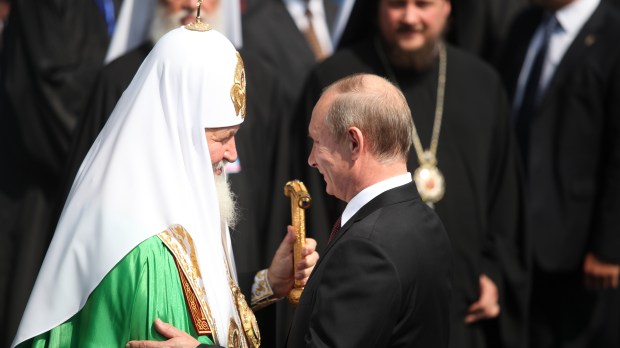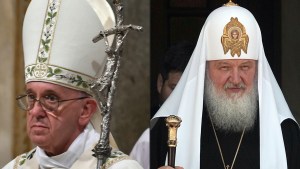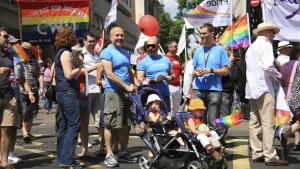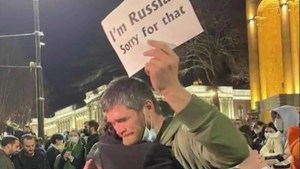Aleteia: You point out that Putin and Kirill are of the same generation. Apart from their age, what do these two men have in common?
Jean-François Colosimo: In Russia, after 1989, only two institutions emerged from the rubble of communism: the KGB and the Church, which have old ties. Kirill immediately entered the race to become patriarch, a goal he achieved in 2009. While he had an initial reputation as a progressive and ecumenist, he took on the anti-Western bias typical of the new authoritarian regime and endorsed Putin’s foreign policy. He becomes in a way his minister of religious affairs. In the same way that Putin leads a multi-ethnic, multi-faith and multilingual federation, Kirill, in the name of Orthodoxy, presides over the Religious Council of Russia, which brings together the Chief Rabbi for Judaism, the Grand Mufti for Islam and the Grand Lama for Buddhism. On the outside, the pontiff and the despot profess the same ideology of the unity of the “Russian world,” in other words, of a Russia that includes all Russian-speaking populations. This pan-Russian imperialism was made possible by the fact that there was no Nuremberg of communism. Putin and Kirill are two survivors of homo sovietus. They agree on the oblivion of the Gulag, the refusal of the international order and the denial of human rights.
The patriarch seeks to affirm the greatness of the Russian Church, just as the president intends to reaffirm the greatness of the Russian state.
What do they bring to each other?
Kirill and Putin are driven by the same restoration project. The patriarch seeks to affirm the greatness of the Russian Church, just as the president intends to reaffirm the greatness of the Russian state. Internally, the Church is taking over the role once played by the Communist Party. It is now in charge of patriotism, morality, social norms and the recruitment of elites. In this context, Kirill intends to imitate the interpretation he has of a 19th-century Catholicism that never existed, a fortress Church which governed society. He wants to make this Church play, against the clock, the great battles against Modernity with an inquisitorial dimension that is not traditionally Orthodox. Outside, Kirill brings his diplomatic support to Putin. The Moscow Patriarchate is the only Russian institution that still covers the whole of the former USSR. It supports the geopolitical maneuvers of the current regime. The representations of the Moscow Patriarchate in Belarus, in Ukraine, but also in the Baltic States, in Kazakhstan and in the Central Asian Republics are in fact second embassies. With its extensions in the former satellite countries and the former sister republics, but also in Europe and in the Americas, the Moscow patriarchate makes up about 50% of the Orthodox world and benefits from the important diplomatic and financial resources reserved for it by the Russian state. The two men walk hand in hand in domestic and foreign policy. The aspergillum blesses the saber and, from now on, the incense burner legitimizes the missile.
In order to establish his hegemony, Kirill has engaged in an arm wrestle with the Patriarch of Constantinople Bartholomew. But the primate of all the Orthodox on a planetary scale, who is resolutely enrolled in an ecumenical approach and who is the first spiritual leader to have promoted ecology, as Pope Francis recognizes, embodies an Orthodoxy that is the opposite of Kirill’s chauvinistic, conservative, moralistic and clerical one. Two conceptions of humanity, of the world and of Christianity are opposed. Like Stalin, Kirill tends to measure power by the number of divisions and therefore to underestimate Bartholomew. He does not see that Bartholomew has history, measurement, experience and primacy. Kirill decides not to come to the Great Pan-Orthodox Council that Bartholomew convenes in Crete in 2016 and he embarks in his refusal the Patriarchate of Antioch, the Church of Bulgaria and the Church of Georgia. The conciliar momentum is achieved. Kirill, however, overestimates his abilities, especially since Ukraine has become a problem between him and Putin.
If the Moscow Patriarchate represents 50% of the Orthodox world, Ukraine constitutes 40% of the Moscow Patriarchate.
Why?
If the Moscow Patriarchate represents 50% of the Orthodox world, Ukraine constitutes 40% of the Moscow Patriarchate. However, the head-on clash between Putin and the West has as its terrain Ukraine, mainly the Crimea and, in the East, the province of Donetsk. The tension rises after 2014 and the Maidan revolution. But Putin already greatly underestimates the existence of the Ukrainian nation: in 1991, 92% of the population voted for independence. The Orthodox are in the majority but divided; in addition to the Church of Moscow, there are two schismatic Churches: one that continues the movement of the catacombs that appeared under communism, the other that Philaret of Kiev, a former disciple of Nicodemus, created to satisfy his personal ambition. However, to be both Orthodox and Ukrainian is becoming more and more difficult: how to be part of a center of spiritual authority allied to a hostile political power?
Has this Ukrainian ecclesiastical independence come about?
In 2019, the Patriarchate of Constantinople grants the Church of Ukraine the status of autocephaly, in other words, self-government. Kirill breaks communion with Bartholomew, declares him a schismatic and denies him any right of primacy. The affair affected the whole of Orthodoxy, the local Churches being summoned to choose their side. Kirill will use all the means of pressure that the foreign policy of the Kremlin allows him. At the end of 2021, while Putin is projecting himself in West Africa, among others in Mali, through the infamous Wagner division, Kirill triggers a schism within the patriarchate of Alexandria, which exercises its jurisdiction on the African continent and which is in favor of the independence of the Church of Ukraine.
Without Ukraine, the Moscow Patriarchate is a Church among others in the Orthodox world.
Are the destinies of Vladimir Putin and Kirill so linked that they risk sinking together?
For Putin, Ukraine exists only as part of Russia. He did not see that the ethnically or linguistically Russian populations would form a block with the patriotic resistance. Kirill did not understand either that the bishops of the autonomous Church that he maintained against the independent Church were gradually disassociating themselves from him and entering into the sacred union in their turn. By justifying an iniquitous and fratricidal war, Kirill made himself a scandal for the Orthodox, but also for the Catholics and Protestants. He will follow Putin in his fall, even if it is not necessarily immediately. The best enemy of Russia today is Putin and the best enemy of Orthodoxy is Kirill. Without Ukraine, the Moscow Patriarchate is just another church in the Orthodox world. It can no longer assert its quantitative reign to act a political reversal of spiritual primacy and it is left to submit and reform itself.
In the same way that Putin muzzled the free press and persecuted the opposition, Kirill has constantly purged the ecclesiastical body of all oppositional elements.
Is there a fracture between the clergy and the faithful in Russia?
The Russian Church today is constituted in the reverse of the pyramidal model that usually governs human communities: the faithful are worth more than the priests who are worth more than the bishops. For reasons of interest, the hierarchy shares Kirill’s ideology. In the same way that Putin muzzled the free press and persecuted the opposition, Kirill has constantly purged the ecclesiastical body of all oppositional elements. Nevertheless, there is still internal opposition. Petitions against the current patriarch are multiplying. We are less far than one might think from a revival of Russian and Slavic spirituality in the spirit of Gogol, Dostoyevsky and Solzhenitsyn.
What opportunities can the Orthodox world draw from current events?
We have witnessed a spectacular reversal of image in the space of half a century. From a spiritual Church, almost immaterial, of contemplation, prayer and liturgy, we have passed to a kind of archaic survival, threatening, incapable of understanding modernity, confusing politics and religion. Let’s not stop at appearances. The question now is how the Orthodox will return to the essential, which is the Gospel, by cleaning themselves of the dross of history. The Ecumenical Patriarchate is willing to do so because it knows the ultimate value of historical tragedies from its own experience. It has been able to transform its difficulties into a kingdom, as they say on Mount Athos, in the image of the God who makes himself powerless so that the true power of the Resurrection may be manifested. Orthodoxy has much to contribute to ecumenical and interreligious dialogues, to the planetary civilization of exchange. The Constantinopolitan vision is very close to the Catholicism that came out of Vatican II, that of a Church that invites us to recognize in Christ the Savior of the world because he is the Servant of humanity.
Interview conducted by Laurent Ottavi.




